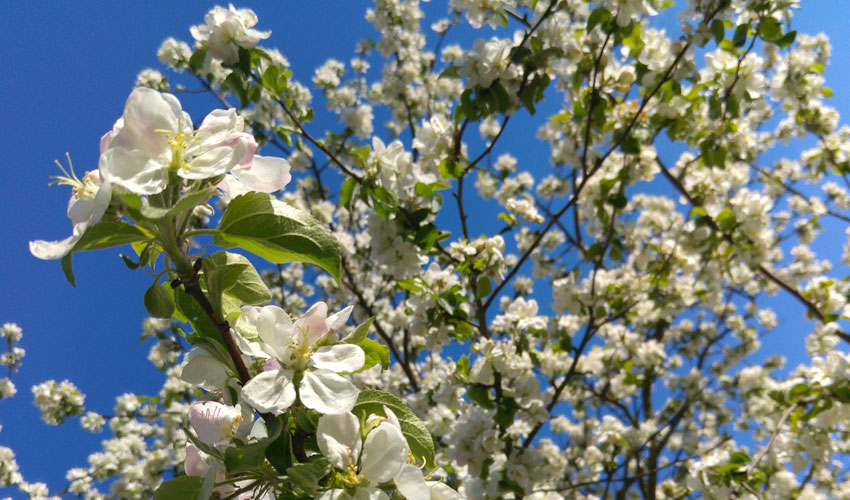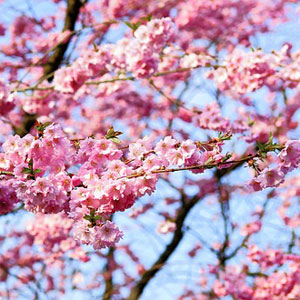
Spring-flowering trees offer the biggest seasonal show of bountiful blooms. And after a cold dreary winter, it’s just what we need to get spring off to a great start.
Many trees that flower in spring are fragrant and feed pollinators, in addition to beautifying our Connecticut landscape. Plus, the best don’t just offer spring flowers – they’re multi-season powerhouses.
My top picks for the best spring-flowering trees are resilient, beautiful, easy to maintain, and just right for growing in Connecticut. They include regional natives, in addition to well-behaved non-native trees with impressive spring flowers.
Serviceberries
 The remarkably hardy downy serviceberry (Amelanchier arborea, 15-25 feet) is a vase-shaped small tree that produces lots of fragrant, delicate white flowers that feed bees in mid-spring. The tough Connecticut native is tolerant of both partial shade and clay soils, in addition to being disease resistant. The spring flowers are followed by edible, tart-sweet, purple-red fruits that are favored by songbirds. Exceptional orange-red fall foliage and smooth gray bark extend its interest into fall and winter.
The remarkably hardy downy serviceberry (Amelanchier arborea, 15-25 feet) is a vase-shaped small tree that produces lots of fragrant, delicate white flowers that feed bees in mid-spring. The tough Connecticut native is tolerant of both partial shade and clay soils, in addition to being disease resistant. The spring flowers are followed by edible, tart-sweet, purple-red fruits that are favored by songbirds. Exceptional orange-red fall foliage and smooth gray bark extend its interest into fall and winter.
There are several downy serviceberry hybrids that are offer exceptional landscape performance. Two of the best are ‘Autumn Brilliance’ (20-25 feet), which offers brilliant red foliage in fall and ‘Forest Prince’ (20 feet), which has an oval shape and wonderful orange-red fall color.
Dogwoods
 American dogwoods are fantastically beautiful Connecticut natives, but they are so prone to the deadly disease anthracnose that I generally don’t recommend them. One variety shown to stand up to anthracnose is ‘Appalachian Spring’, which has pretty, white, mid-spring flowers and eye-catching red fruits and foliage in fall.
American dogwoods are fantastically beautiful Connecticut natives, but they are so prone to the deadly disease anthracnose that I generally don’t recommend them. One variety shown to stand up to anthracnose is ‘Appalachian Spring’, which has pretty, white, mid-spring flowers and eye-catching red fruits and foliage in fall.
A better choice for us here in Connecticut is the Korean dogwood (Cornus kousa), a popular landscape dogwood with spectacular late spring flowers. You’ll love its four seasons of interest and reliable disease resistance. The multi-stemmed, picturesque tree produces white or russet pink spring flowers followed by attractive, round, coral red fruits that mature in late summer. The fall leaves turn shades of red, orange, and purple, and its beautiful mottled bark adds winter interest.
Flowering Cherries
 Weeping flowering cherries lend classic beauty to spring landscapes and some offer added landscape interest after the flowers have faded. The Weeping Extraordinaire™ Double Flowering Cherry (Prunus ‘Extrazam’, 20 feet) is vigorous and bears spectacular double pink blooms in early spring. In fall, its crisp green foliage turns burgundy.
Weeping flowering cherries lend classic beauty to spring landscapes and some offer added landscape interest after the flowers have faded. The Weeping Extraordinaire™ Double Flowering Cherry (Prunus ‘Extrazam’, 20 feet) is vigorous and bears spectacular double pink blooms in early spring. In fall, its crisp green foliage turns burgundy.
A stellar, non-weeping flowering cherry is the Kwanzan cherry (Prunus ‘Kwanzan’, 20-30 feet). It has a broad, spreading habit, and offers a wealth of fully double, pink blooms in mid-spring. In fall, its leaves turn coppery shades and younger trees have attractive, peeling mahogany bark.
Crabapples
 Crabapples lost favor with Connecticut homeowners because of chronic disease problems, but newer varieties are wonderfully disease resistant. The red-flowered Prairifire crabapple (Malus ‘Prairifire’, 15-20 feet), is a perfect example. High disease resistance, colorful spring flowers, and persistent red crabapples have made it a top-notch landscape tree.
Crabapples lost favor with Connecticut homeowners because of chronic disease problems, but newer varieties are wonderfully disease resistant. The red-flowered Prairifire crabapple (Malus ‘Prairifire’, 15-20 feet), is a perfect example. High disease resistance, colorful spring flowers, and persistent red crabapples have made it a top-notch landscape tree.
Two more remarkably compact and disease resistant crabapples include the white-flowered, orange-fruited ‘Adirondack’ (Malus ‘Adirondack’, 12 feet), and dwarf, spreading ‘Tina’ (Malus sargentii ‘Tina’, 5 feet), which has fragrant white flowers and red fall fruits.
Redbud
 Native redbuds (Cercis canadensis, 20-30 feet) look like puffs of reddish smoke when in bloom and pair beautifully with American dogwoods. Brilliant, bee-pollinated, purple-red flowers line the bare branches in mid-spring. The trees have an attractive, broad, branching structure and heart-shaped leaves that look pretty through summer. Two unique landscape varieties include the purple-leaved ‘Forest Pansy’ and chartreuse-leaved ‘Hearts of Gold’.
Native redbuds (Cercis canadensis, 20-30 feet) look like puffs of reddish smoke when in bloom and pair beautifully with American dogwoods. Brilliant, bee-pollinated, purple-red flowers line the bare branches in mid-spring. The trees have an attractive, broad, branching structure and heart-shaped leaves that look pretty through summer. Two unique landscape varieties include the purple-leaved ‘Forest Pansy’ and chartreuse-leaved ‘Hearts of Gold’.
Before choosing the right spring-flowering tree for your Connecticut landscape, consider your yard’s space, light, and soil. Most spring-flowering trees perform best in full to partial sun and prefer well drained soils of average to good fertility. If you’re unsure, give us a call – we’re happy to take a look at your property and recommend appropriate trees for your location.
Once you’ve found the right spot, plant one or more of these beautiful spring-flowering trees to make your spring extra fragrant, colorful, and beautiful.



